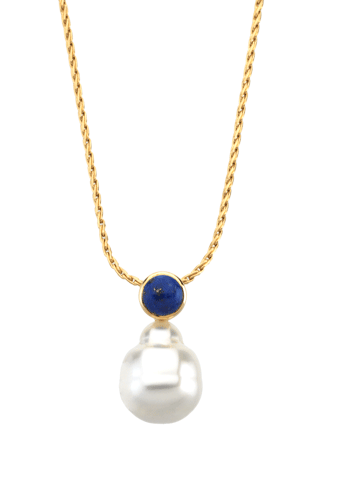- Total $ 0.00
Sell With A Story: Lapis Lazuli

SELL WITH A STORY: LAPIS LAZULI

Rough Lapis • Photo Credit: GIA
High-quality lapis has such an extraordinary color that, once seen, you can never forget it. This intense, brilliant blue defies easy description. Across all cultures blue is chosen as the favorite color and it is considered calming. But personally, I find lapis blue a lavish exciting color that grabs your attention and holds it.
Relationship skills
For more than six millennia, lapis has maintained a close, long-term relationship with humans. This seems simple enough: it sits there looking beautiful while we do all the work. On the other hand, looking beautiful for 6,500 years would be exhausting for any of us. During this time, we created lapis decorative objects and jewelry of exceptional beauty and value.
At what cost?
Today, lapis is, for the most part, inexpensive but this wasn’t always the case. From Medieval times to the 18th century, lapis cost as much as gold. It came from only one source (we know it today as northeast Afghanistan) and was imported at great cost. Like the finest silks and spices, if you wanted fine quality lapis, you paid.
It’s a grind
Ground to the finest powder, lapis was used as eye shadow in ancient Egypt and later, when mixed with a binding agent, as a paint called “ultramarine.” Long considered the most perfect and expensive color, great artists would insist that their wealthy patrons provide it. Why? The color was so perfect nothing could substitute. In the early 19th century, scientists found a way to make synthetic ultramarine. It’s beautiful — but not as beautiful as the real thing.
Famous friends
The most famous painters who used ultramarine include Leonardo da Vinci who chose it for the Madonna’s cloak in several paintings, Michelangelo who chose ultramarine to paint heaven in the Sistine Chapel and Vermeer who painted the headscarf of “Girl With The Pearl Earring” with ultramarine.
What’s in a name?
Lapis is simply the Latin word for “stone.” The word lazuli originated from the Persian word “lazhward.” This word means the rich azure blue of the sky. So lapis lazuli means “blue stone” and oh, what a dazzling blue!
The nitty gritty
Where does lapis get its alluring blue? It comes from “lazurite,” a mineral compound of sulfates, sulfur, and chlorine that accounts for 20% to 40% of lapis’ weight. Higher lazurite content creates a more intense blue that gives a stone greater value. Calcite is the other significant chemical component but too much calcite lightens the color and causes white streaks that lower the stone’s value. Lapis also has pyrite content. The tiny gold flecks distinguish it from sodalite.
Hmmm, this smells like top quality
Cutters “turn up their nose” when working on lapis because the smell of burning sulfur is not at all pleasant. Expert cutters can gauge the color intensity when the cutting disc touches it. You’d think that seeing it would be enough but the smell gives greater accuracy.
September or December
In the United Kingdom, lapis is an alternate birthstone for September. After all, It’s a rich blue like sapphire and much less expensive. Other sources mention it as the traditional birthstone for December. I discovered that, in 1912, when the National Association of Jewelers (now Jewelers of America) standardized the birthstone list, December’s birthstones were turquoise and lapis. So you can take your pick.
Blue Beauties
If you have a customer who wants the very finest quality of lapis from Afghanistan, our Special Order Service can help you. We sell calibrated lapis from Afghanistan, perfect for birthstone and fashion jewelry.
Mining Lapis
The finest lapis in the world is still found in Sang-e-Sar, Northeast Afghanistan, where it has been mined for about 6,500 years. The mountainous region’s forbidding winter means the Afghan people can mine lapis only during the summer months. They bring the finest stones down from the mountains by mule. Chile’s Cordillera State is another major producer. Lesser quantities are found west of Lake Baikal in Siberia, South Baffin Island in Canada, Italy’s Alban Hills near Rome, and Mogok, Myanmar.
The Lapis Lazuli Room
Empress Catherine the Great (1729-1796) of Russia was famous for her love of extravagant palaces. She built several and restored others. In one of these, she adorned an entire room with lapis lazuli, much of it mined west of Lake Baikal. The room had lapis walls, fireplaces, doors, mirror frames, tables and more. I can’t find any pictures of it so it may have been destroyed during one of Russia’s wars but I sure wish I could see it.
Lapis meaning and powers
Tibetan Buddhists associate brilliant lapis blue with wisdom. I believe that makes it a wise choice for everyone. And it lends itself to men’s jewelry as much as women’s. More recently, it has developed the power to enhance memory, boost creativity, and relieve anxiety. Lapis sounds like the perfect antidote for the stressful lifestyle many of us live. But I’m most impressed by the power of lapis to build friendship and trust. Could anything be more precious?







